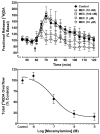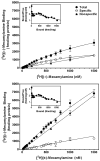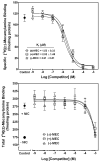Potential therapeutic uses of mecamylamine and its stereoisomers
- PMID: 23603417
- PMCID: PMC3690754
- DOI: 10.1016/j.pbb.2013.04.005
Potential therapeutic uses of mecamylamine and its stereoisomers
Abstract
Mecamylamine (3-methylaminoisocamphane hydrochloride) is a nicotinic parasympathetic ganglionic blocker, originally utilized as a therapeutic agent to treat hypertension. Mecamylamine administration produces several deleterious side effects at therapeutically relevant doses. As such, mecamylamine's use as an antihypertensive agent was phased out, except in severe hypertension. Mecamylamine easily traverses the blood-brain barrier to reach the central nervous system (CNS), where it acts as a nicotinic acetylcholine receptor (nAChR) antagonist, inhibiting all known nAChR subtypes. Since nAChRs play a major role in numerous physiological and pathological processes, it is not surprising that mecamylamine has been evaluated for its potential therapeutic effects in a wide variety of CNS disorders, including addiction. Importantly, mecamylamine produces its therapeutic effects on the CNS at doses 3-fold lower than those used to treat hypertension, which diminishes the probability of peripheral side effects. This review focuses on the pharmacological properties of mecamylamine, the differential effects of its stereoisomers, S(+)- and R(-)-mecamylamine, and the potential for effectiveness in treating CNS disorders, including nicotine and alcohol addiction, mood disorders, cognitive impairment and attention deficit hyperactivity disorder.
Published by Elsevier Inc.
Figures





Similar articles
-
Mecamylamine - a nicotinic acetylcholine receptor antagonist with potential for the treatment of neuropsychiatric disorders.Expert Opin Pharmacother. 2009 Nov;10(16):2709-21. doi: 10.1517/14656560903329102. Expert Opin Pharmacother. 2009. PMID: 19874251 Review.
-
Nicotine induced seizures blocked by mecamylamine and its stereoisomers.Life Sci. 2001 Oct 19;69(22):2583-91. doi: 10.1016/s0024-3205(01)01338-8. Life Sci. 2001. PMID: 11712662
-
Similar activity of mecamylamine stereoisomers in vitro and in vivo.Eur J Pharmacol. 2013 Nov 15;720(1-3):264-75. doi: 10.1016/j.ejphar.2013.10.018. Epub 2013 Oct 23. Eur J Pharmacol. 2013. PMID: 24161916 Free PMC article.
-
Analysis of mecamylamine stereoisomers on human nicotinic receptor subtypes.J Pharmacol Exp Ther. 2001 May;297(2):646-56. J Pharmacol Exp Ther. 2001. PMID: 11303054
-
Mecamylamine (Inversine): an old antihypertensive with new research directions.J Hum Hypertens. 2002 Jul;16(7):453-7. doi: 10.1038/sj.jhh.1001416. J Hum Hypertens. 2002. PMID: 12080428 Review.
Cited by
-
Green tobacco sickness: mecamylamine, varenicline, and nicotine vaccine as clinical research tools and potential therapeutics.Expert Rev Clin Pharmacol. 2019 Mar;12(3):189-195. doi: 10.1080/17512433.2019.1570844. Epub 2019 Jan 24. Expert Rev Clin Pharmacol. 2019. PMID: 30650314 Free PMC article. Review.
-
Self-administration of the synthetic cathinone MDPV enhances reward function via a nicotinic receptor dependent mechanism.Neuropharmacology. 2018 Jul 15;137:286-296. doi: 10.1016/j.neuropharm.2018.05.008. Epub 2018 May 9. Neuropharmacology. 2018. PMID: 29778945 Free PMC article.
-
Anxiolytic- and antidepressant-like effects of the methadone metabolite 2-ethyl-5-methyl-3,3-diphenyl-1-pyrroline (EMDP).Neuropharmacology. 2016 Feb;101:46-56. doi: 10.1016/j.neuropharm.2015.09.012. Epub 2015 Sep 11. Neuropharmacology. 2016. PMID: 26365569 Free PMC article.
-
Mecamylamine inhibits seizure-like activity in CA1-CA3 hippocampus through antagonism to nicotinic receptors.PLoS One. 2021 Mar 12;16(3):e0240074. doi: 10.1371/journal.pone.0240074. eCollection 2021. PLoS One. 2021. PMID: 33711021 Free PMC article.
-
Critical needs in drug discovery for cessation of alcohol and nicotine polysubstance abuse.Prog Neuropsychopharmacol Biol Psychiatry. 2016 Feb 4;65:269-87. doi: 10.1016/j.pnpbp.2015.11.004. Epub 2015 Nov 12. Prog Neuropsychopharmacol Biol Psychiatry. 2016. PMID: 26582145 Free PMC article. Review.
References
-
- Abdulla FA, Bradbury E, Calaminici MR, Lippiello PM, Wonnacott S, Gray JA, Sinden JD. Relationship between up-regulation of nicotine binding sites in rat brain and delayed cognitive enhancement observed after chronic or acute nicotinic receptor stimulation. Psychopharmacology. 1996;124:323–331. - PubMed
-
- Ait-Daoud N, Wiesbeck GA, Bienkowski P, Li MD, Pfutzer RH, Singer MV, Lesch OM, Johnson BA. Comorbid alcohol and nicotine dependence: From the biomolecular basis to clinical consequences. Alcohol Clin Exp Res. 2005;29:1541–1549. - PubMed
-
- Andreasen JT, Olsen GM, Wiborg O, Redrobe JP. Antidepressant-like effects of nicotinic acetylcholine receptor antagonists, but not agonists, in the mouse forced swim and mouse tail suspension tests. J Psychopharmacol. 2009;23:797–804. - PubMed
-
- Andreasen JT, Redrobe JP. Nicotine, but not mecamylamine, enhances antidepressant-like effects of citalopram and reboxetine in the mouse forced swim and tail suspension tests. Behav Brain Res. 2009a;197:150–6. - PubMed
-
- Andreasen JT, Redrobe JP. Antidepressant-like effects of nicotine and mecamylamine in the mouse forced swim and tail suspension tests: Role of strain, test and sex. Behav Pharmacol. 2009b;20:286–295. - PubMed
Publication types
MeSH terms
Substances
Grants and funding
LinkOut - more resources
Full Text Sources
Other Literature Sources
Research Materials

